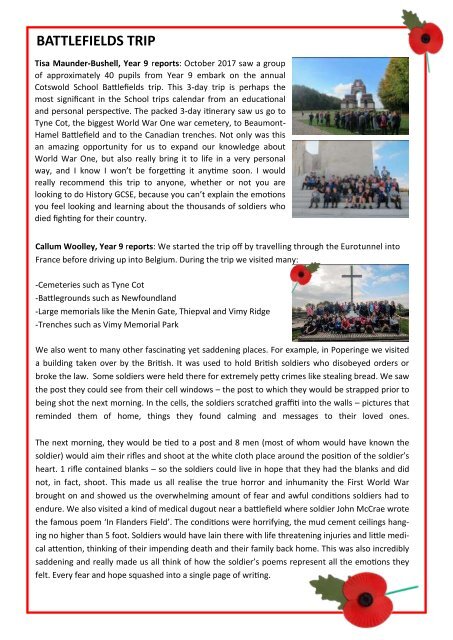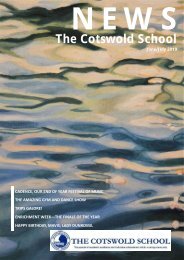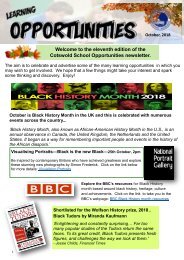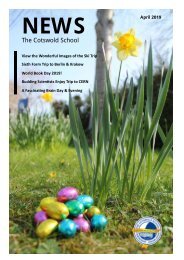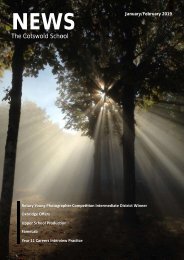Create successful ePaper yourself
Turn your PDF publications into a flip-book with our unique Google optimized e-Paper software.
BATTLEFIELDS TRIP<br />
Tisa Maunder-Bushell, Year 9 reports: October 2017 saw a group<br />
of approximately 40 pupils from Year 9 embark on the annual<br />
Cotswold School Battlefields trip. This 3-day trip is perhaps the<br />
most significant in the School trips calendar from an educational<br />
and personal perspective. The packed 3-day itinerary saw us go to<br />
Tyne Cot, the biggest World War One war cemetery, to Beaumont-<br />
Hamel Battlefield and to the Canadian trenches. Not only was this<br />
an amazing opportunity for us to expand our knowledge about<br />
World War One, but also really bring it to life in a very personal<br />
way, and I know I won’t be forgetting it anytime soon. I would<br />
really recommend this trip to anyone, whether or not you are<br />
looking to do History GCSE, because you can’t explain the emotions<br />
you feel looking and learning about the thousands of soldiers who<br />
died fighting for their country.<br />
Callum Woolley, Year 9 reports: We started the trip off by travelling through the Eurotunnel into<br />
France before driving up into Belgium. During the trip we visited many:<br />
-Cemeteries such as Tyne Cot<br />
-Battlegrounds such as Newfoundland<br />
-Large memorials like the Menin Gate, Thiepval and Vimy Ridge<br />
-Trenches such as Vimy Memorial Park<br />
We also went to many other fascinating yet saddening places. For example, in Poperinge we visited<br />
a building taken over by the British. It was used to hold British soldiers who disobeyed orders or<br />
broke the law. Some soldiers were held there for extremely petty crimes like stealing bread. We saw<br />
the post they could see from their cell windows – the post to which they would be strapped prior to<br />
being shot the next morning. In the cells, the soldiers scratched graffiti into the walls – pictures that<br />
reminded them of home, things they found calming and messages to their loved ones.<br />
The next morning, they would be tied to a post and 8 men (most of whom would have known the<br />
soldier) would aim their rifles and shoot at the white cloth place around the position of the soldier’s<br />
heart. 1 rifle contained blanks – so the soldiers could live in hope that they had the blanks and did<br />
not, in fact, shoot. This made us all realise the true horror and inhumanity the First World War<br />
brought on and showed us the overwhelming amount of fear and awful conditions soldiers had to<br />
endure. We also visited a kind of medical dugout near a battlefield where soldier John McCrae wrote<br />
the famous poem ‘In Flanders Field’. The conditions were horrifying, the mud cement ceilings hanging<br />
no higher than 5 foot. Soldiers would have lain there with life threatening injuries and little medical<br />
attention, thinking of their impending death and their family back home. This was also incredibly<br />
saddening and really made us all think of how the soldier’s poems represent all the emotions they<br />
felt. Every fear and hope squashed into a single page of writing.


